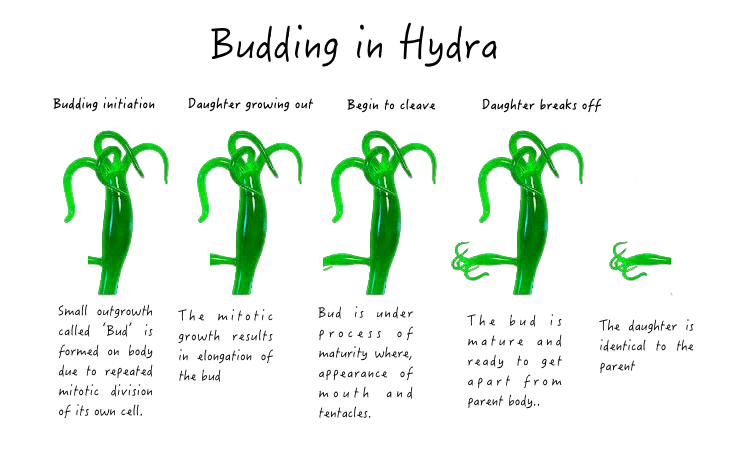Introduction to Asexual Reproduction-
Reproduction is a biological process by which an organism produces its offspring. It is called as reproduction because it allows re-production of its own types. This biological process assures the continuity of species production from generation to generation and hence continuing the life on earth. There are two modes of reproduction – sexual and Asexual.
Sexual reproduction – When there is an involvement of two genders it is called as sexual reproduction. Where male and female gametes (sex cells) fused to form on offspring. When fusion of gamates occur inside the female body it is called as Internal Fertilization. Whereas when fusion occurs outside the body, it is called as External Fertilization. Sexual reproduction do not form clones. Infact, the characterisitcs from the parents are transferred to the offspring.
Asexual reproduction – In this type of reproduction, only one parent is involved and there is no fusion of gamates. Such type of reproduction usually results in the formation of clones. The archea, Algae, bacteria and many protozoa, fungi, plants and few animals reproduce asexually.
There are 7 different modes of asexual reproduction –
- Binary fission
- Budding
- Vegetative reproduction
- Fragmentation
- Sporogenesis
- Parthenogenesis
- Apomixis
1. Binary Fission {Binary-division of something into two, Fission-division}
- It is type of asexual reproduction in which single individual cell (parent cell) divide into two cell (daughter cell) having same genetic material.
- Bacteria cell reproduces through binary fission.
- The main purpose is to provide same DNA (genetic material/genetic information) to each daughter cell.
- Normally bacteria takes 0-80 minutes to divide into two daughter cells; however, in E.coli multiplies in 20-30 minutes.Bacteria completes cell division through following 3 steps –

a) Replication of DNA
- Process responsible for making multiple copies of DNA.
- As cell does not contain nucleus therefore, chromosome separation does not take place. Genetic material(NUCLEIOD) is present inside cytoplasm.
- DNA replication start from the origin point (ORI POINT) where the coiled DNA divide or separate DNA strains. Following this genetic material gets duplicate.
- Due to small size and less complexation DNA gets replicate fast of bacteria.
b) Growth of cell –
- Here, parent cell is ready to go under binary fission process to divide into two daughter cell.
- Cell takes access of nutrition and results in bigger size because of increase in cytoplasmic content. Meanwhile, due to circularity the strains migrate and get attach themselves to plasma membrane on different sides.
c) Fission(division) of cell –
- It leads to the elongation of cell and cell start separating from opposite poles.
- This division make sure that each cell gets same and equal genetic material/cytoplasmic material.
- Cytokinesis take place here (Process through which cytoplasm gets divide).
- During this cytoplasmic division formation of SEPTUM (thick middle layer) take place between two cell.
- This formation of septum is controlled by group of protein mainly (FTsZ PROTEIN)
d) FTsZ protein-filamenting temperature sensitive protein –
- This protein locate itself in the middle of cell and lead to formation of Z-RING.
- Its binding protein get associated with other additional dozen protein which initiate formation of septum with peptidoglycan and allows daughter cell to divide. .
2. Budding –
It results in the development of new organism from the outer growth of bud due to occurrence of cell division at particular site .In some species buds may be produces from almost any point of body, but in many cases budding occurs at specialized area. The bud detaches from the parent body after maturation and become new individual independent.
Example: budding in hydra
It is carried out by following steps –

3. Vegetative reproduction –
- It is specified as regeneration of new plant from cut vegetative part of parent plant or from the plant portion.it occurs in plant by including any structural part of plant therefore, the used structural part is recognized as Vegetative propagules. Ex; rhizome (Strawberry), bulb, tuber, plantlets etc. For the most time plant naturally reproduce through this way but it can also be induced through artificial techniques
It is grouped in following 2 types –
A) Naturally reproduce by involvement of stem, leaf and root.
a) Rhizome – Also known as Stolon’s. they are modified stem that grow the existing stem. Ex. Strawberries.
b) Tubers – They can either develop from stem or the root. Stem tuber generate from runners whereas, Root tuber propagate from roots that are modified for the purpose of nutrition storage and production of new plant. EX; Stem tubers: Potatoes Root tubers: Sweet potatoes.
c) Bulb – Bulbs are puffed out parts of stem within which shoot of new plant is present. They are underground surrounded by layered leaves and plumps responsible to provide nutrients to new plant. Ex. lilies
d) Plantlets – Plantlets are small structure arise from meristem in leaf margins which lead to root development and finally drop down from the leave they grew from. Ex.Bryophyllum daigremontianum.
e) Offset of water Hyacinth – Vegetative propagation in Eichhornia (water hyacinth) takes place by offset, which develop from below a tuff or rosette of leaves, grow for sometime bear a new tuft or rosette of leaves at its tips.
B) Artificially by including cutting, grafting, layering and micropropogation.
a) Cutting – A part of plant is cut mostly stem, treated with harmones in order to enhance growth and then planted. The root start growing and it leads to the development of new plant. Ex. Rose
b) Grafting – Grafting includes attachment of cut part of plant (scion) to the stem of another plant (stock). The scion carries the desired characteristic. Eventually a new plant with integrated characteristics develops. Ex. Mango
c) Layering – It includes the bending of plant branches or stem so that they touch the ground and are covered with soil. The point at which stem touches the ground start producing external roots. This results in the production of new plant. Ex.Jasmine.
d) Micropropogation – It is in-vitro technique. In this method, the small part of sample plant is excised, called as explant. It is inoculated in fresh and sterile media. The media contains appropriate plant hormones. And then it is incubated in laboratory in favourable conditions. This results in the formation of clone plants.
4. Fragmentation –
An individual organism break into two or more than two fragment that develop into a new mature individual that are clones of original organism. Occurs in many plants, as well as in some animals Ex. Star fish
Here starfish had lost its arm and that fragmented part grows into a new mature an indivdual while the parent regrow its lost arm.

5 Sporogenesis –
It is process of asexual reproduction by means of spore. Spore are present in sporangium (sac-like structure) which is seen in organism under some unfavourable condition.Spore are not seed as they lack the embryo produced by male and female gamete fusion, they are thick-walled and highly resistant to various environmental condition, when they have their favourable condition the sporangium brust opens and spore are released that germinate to give rise to new individual.
- Sporangium
- Spore
- Food source
- Hyphae
6 Parthenogenesis –
Parthinogenesis is an asexual reproduction where the offspring develops from female gamete without fertilization with male gamete. The Pathenogenesis are divided into two categories
- Apomictic parthenogenesis – where the egg cell produce by mitosis does not undergo meiosis and directly give rise to embryos. In such cases the produced offsprings are clones of the parthenogenetic parents.
- Automictic parthenogenesis – where reproductive cell undergo meiosis, the well developed egg cell can develop into embryo though without prior fertilization by a sperm cell.There are numbers of animals that reproduce asexually through this mode.Ex; Nematodes, rotifers, lizard, snake.
7 Apomixis –
Also known as asexual seed formation. It is phenomenon that occur without fertilizatrion but result in formation of embro and seed. In this type, replacement of seed by plantlet (young or small plant) or replacement of flower by bubils take place. However, replacement of genetic material of an egg by genetic material of pollen took place in paternal apomixis. it helps to have a seed with desired characters by preventing loss of specific character of parent/hybrid.This method of reproduction is very cheap and quick.



2 thoughts on “Different types of Asexual Reproduction”